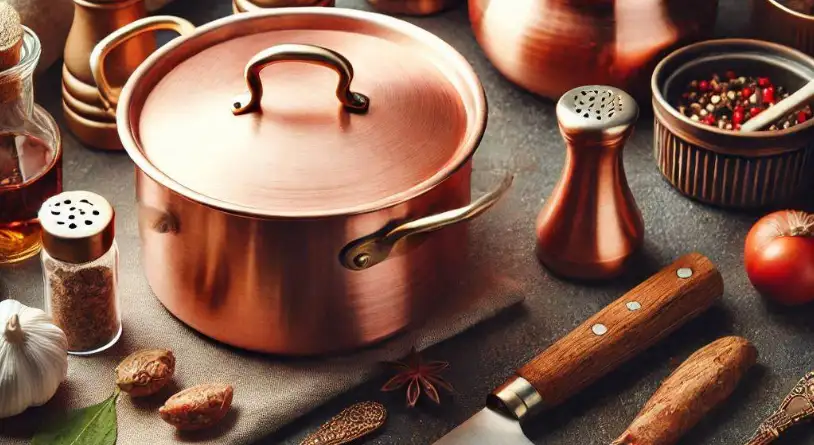Copper cookware has been a prized kitchen tool for millennia, valued for its exceptional heat conductivity and aesthetic appeal.
However, the question of whether copper is safe for cooking often arises. The answer is yes—modern copper cookware is designed with safety in mind.
This article explores the history, advantages, and proper care of copper cookware to help you decide if it’s the right choice for your kitchen.
The History of Copper Cookware
Copper cookware dates back over 10,000 years, originating in the Middle East. Ancient civilizations like Egypt and Mesopotamia utilized copper for its malleability and superior heat conduction, making it a significant upgrade from stone cooking tools.
Copper cookware continued to evolve, becoming integral to Spanish dishes like paella and Indian cuisine with tools such as the kadhai. Its longstanding reputation is a testament to its utility and versatility.
Benefits of Copper Cookware
- Unparalleled Heat Conductivity
Copper is ten times more conductive than stainless steel and twice as conductive as aluminum. This makes it ideal for recipes requiring precise temperature control, such as delicate sauces or proteins. - Even Heat Distribution
Copper ensures consistent cooking by evenly distributing heat across the pan’s surface. This prevents hotspots, reducing the risk of unevenly cooked food. - Timeless Aesthetics
Beyond functionality, copper cookware is a stunning addition to any kitchen. Whether displayed on walls or used as tableware, it adds a warm, sophisticated touch. - Ideal for Specialty Cooking
Unlined copper cookware is excellent for making jams, jellies, and meringues due to its unique chemical reactions with sugar and egg whites, producing smooth textures and firm consistencies.
Safety Considerations
Lined vs. Unlined Copper Cookware
Most modern copper cookware is lined with non-reactive metals like stainless steel, tin, or nickel to prevent copper from leaching into food.
This is especially important when cooking acidic ingredients, as they can react with unlined copper, altering the flavor and posing potential health risks.
Unlined copper is better suited for non-heated applications, such as mixing bowls for whisking eggs or preparing desserts.
Trace amounts of copper enhance these foods without compromising safety.
Health Implications of Copper
While copper is an essential trace element for the human body, excessive intake can lead to health concerns. Always use lined copper cookware for heated recipes and avoid cooking highly acidic foods in unlined copper pans.
Care and Maintenance of Copper Cookware
- Use Gentle Utensils
Avoid abrasive utensils, which can scratch the lining or surface of your cookware. Opt for wooden, silicone, or other non-abrasive tools. - Hand Wash Only
Never place copper cookware in the dishwasher. Hand wash with warm soapy water and dry immediately to prevent tarnishing. For deeper cleaning, use a mixture of salt and vinegar to restore its shine. - Polish Regularly
Copper can oxidize over time, developing a green patina similar to the Statue of Liberty. To maintain its red-bronze glow, polish regularly with lemon juice or a specialized copper cleaner. - Monitor for Damage
Tin-lined copper cookware may require relining after extended use, especially if cracks or flaking appear. Stainless steel-lined options are more durable but still require careful handling. - Proper Storage
Hang copper cookware on walls or racks to prevent scratches and dents. If stored in cabinets, use protectors to avoid surface damage.
Choosing the Right Copper Cookware
For those starting with copper cookware, consider purchasing high-quality, lined options.
Stainless steel-lined copper pans offer a balance of beauty, durability, and safety, making them ideal for modern kitchens.
While these pieces are an investment, they can last a lifetime with proper care.
Applications in Cooking
- Lined Copper Cookware
Perfect for sauces, delicate proteins, and dishes requiring precise heat control. - Unlined Copper Cookware
Best for making jams, jellies, and whipping egg whites. The chemical reactions enhance texture and firmness, creating culinary masterpieces.
Is Copper Cookware Worth It?
Copper cookware is more than a kitchen tool—it’s a statement of culinary expertise. Its benefits in heat control and cooking performance are unparalleled, and its aesthetic charm elevates any kitchen. While it requires careful maintenance and comes at a premium price, its longevity and functionality justify the investment.
Final Thoughts
For serious home chefs and professionals, copper cookware delivers unmatched results. Whether you’re perfecting a delicate hollandaise sauce or crafting homemade jams, copper is a reliable ally in the kitchen. With proper care, these beautiful pieces can serve as both functional tools and heirloom-worthy decorations.
So, is copper cookware right for you? If you’re ready to embrace its benefits and commit to its care, copper will reward you with a lifetime of exceptional cooking experiences.
Upgrade your kitchen with copper cookware! Explore our recommended options and start cooking like a pro.

